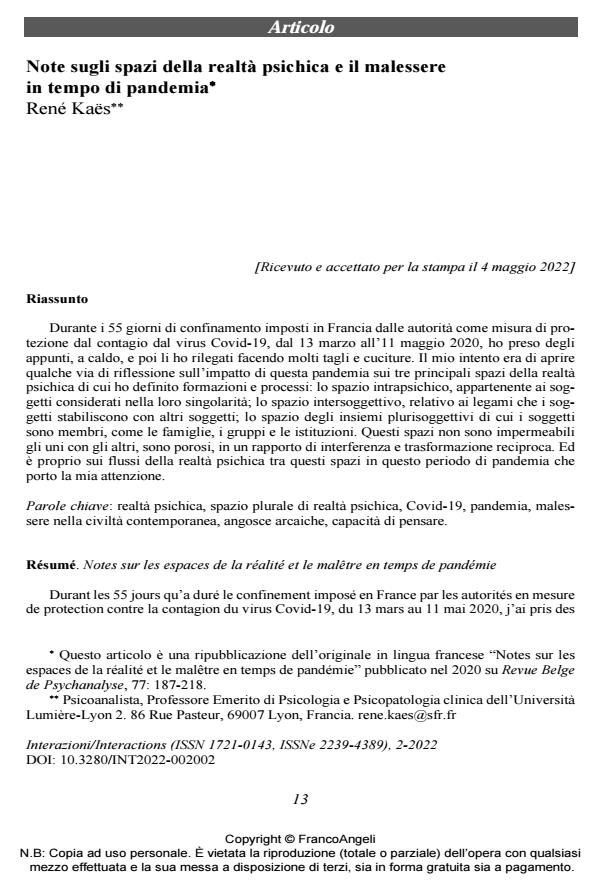Notes on the spaces of mental reality and unease in times of pandemic
Journal title INTERAZIONI
Author/s René Kaës
Publishing Year 2022 Issue 2022/2
Language Italian Pages 29 P. 13-41 File size 251 KB
DOI 10.3280/INT2022-002002
DOI is like a bar code for intellectual property: to have more infomation
click here
Below, you can see the article first page
If you want to buy this article in PDF format, you can do it, following the instructions to buy download credits

FrancoAngeli is member of Publishers International Linking Association, Inc (PILA), a not-for-profit association which run the CrossRef service enabling links to and from online scholarly content.
During the 55 days of detention imposed by the French authorities as a protective measure to control the spread of the Covid-19 virus, from 13 March to 11 May, I made notes and linked to several cuts and scars. It was my intention to open some lines of reflection on the impact of this pandemic on three major domains or spaces of psychological reality of which I characterized the formations and processes as follows: the intraspychic space of which I was dedicated to subjects in their singularity; these of the intersubjective, of the connections they make with other subjects; these of pluri-subjective ensembles such as families, groups and institutions. These spaces are not closed off, they are porous in relation to mutual influence and transformation. So it is the flux of the mental reality between these areas during the pan-demic that I focus my attention. In particular, she focuses on what seems to me to be the back-ground of the malaise in contemporary culture, an unease that affects both the ewhole and each of the psychic spaces separately. These notes reflect my preliminary and partial reflections on the spaces of mental reality and manifestations of malaise during this period of pandemic.
Keywords: mental reality, areas of psychic reality, Covid-19, pandemic, unease in contempo-rary society, archaic fears, ability of thought.
- Anzieu D. (1985). Le Moi-peau. Paris: Dunod.
- Bion W.R. (1961). Théorie de la pensée. Revue Française de Psychanalyse, 1964, 28, 1: 75-84.
- Bloch M. (1939-1954). Le Principe Espérance. Tome 1, 1968 – Tome 2, 1982. Paris: Gallimard.
- Bronstein C., Hacker A.-L. (2012). Bion, la rêverie, la contenance et le rôle de la barrière de contact. Revue Française de Psychanalyse, 76, 3: 769-778.
- Delumeau J. (1978). La peur en Occident. Paris: Fayard.
- Dostaler G., Maris B. (2009). Capitalisme et pulsion de mort. Paris: Albin Michel.
- Elias N. (1987). La Société des individus. Paris: Fayard, 1997.
- Foulkes S.H. (1964). Therapeutic Group-Analysis. London: George Allen & Unwin.
- Freud S. (1895). Esquisse d’une psychologie scientifique. In Freud S., La naissance de la psychanalyse. Paris: PUF.
- Freud S. (1900). L’interprétation des rêves. OC, vol. IV. Paris: PUF.
- Freud S. (1911). Formulations sur les deux principes du cours des événements psychiques. OC, vol. XI. Paris: PUF.
- Freud S. (1914). Pour introduire le narcissisme. OC, vol. XII. Paris: PUF.
- Freud S. (1921). Psychologie des masses et analyse du Moi. OC, vol. XVI. Paris: PUF.
- Freud S. (1929). Malaise dans la civilisation. OC, vol. XVIII. Paris: PUF.
- Kaës R. (1993). Le groupe et le sujet du groupe. Paris: Dunod.
- Kaës R. (1994). La Parole et le lien. Paris: Dunod.
- Kaës R. (2007). Un singulier pluriel. Paris: Dunod.
- Kaës R. (2012). Le Malêtre. Paris: Dunod.
- Kaës R. (2015). L’extension de la psychanalyse. Pour une métapsychologie de troisième type. Paris: Dunod.
- Lacan J. (1966). Écrits. Paris: Dunod.
- Lacan J. (1974-1975). Séminaire XXII de Jacques Lacan (1974-1975) RSI (sem 22). Trascritto e pubblicato sulla rivista Ornicar. -- http://www.idixa.net/Pixa/pagixa-0605021459.html
- Lakoff A. (2020). Les maladies infectieuses ont fait l’objet de mesures de préparation à la fin des années 1990. Entretien avec M.O. Behreer. Le Monde, 23 avril 2020.
- Lanotte P. (2008). Les grandes épidémies: la peste, le choléra et la tuberculose. -- www/htpp/microbiologie.univ-tours.fr/2008lanottepgdes_epidemies.pdf.
- Latour B. (2020). Imaginer les gestes-barrières contre le retour à la production d’avant-crise. -- https://aoc.media/opinion/2020/03/29/imaginer-les-gestes-barrieres-contre-le-retour-a-la-production-davant-crise
- Le Moigne J.-L., Morin E. (1999). Intelligence de la complexité. Paris: L’Harmattan.
- Matot J.-P. (2019). L’Homme décontenancé: de l’urgence d’étendre la psychanalyse. Paris: L’Harmattan.
- Michel J.-D. (2020). Anatomie d’un désastre. Entretien, 26 avril 2020. -- https://youtube/4MqArCjrkml
- Morin E. (1990). Introduction à la pensée complexe. Paris: Éditions sociales françaises.
- Morin E. (2020). Cette crise nous pousse à nous interroger sur notre mode de vie, sur nos vrais besoins masquès dans les aliénations du quotidien. Entretien de Nicolas Truong. Le Monde, 19 avril 2020.
- Mouterde P. (2020). Les maladies émergentes favorisées par la dégradation de la biodiversité. Le Monde, 8 avril 2020.
- Pradeu Th. (2020). Les limites du soi. Immunologie et identité biologique. Montréal/Paris: Presses de l’Université de Montréal et Paris Librairie Vrin.
- Péruchon M. (2009). Figures de l’hypercomplexité en gériatrie, ou du destin des forces de déconstruction et de construction. Cliniques Méditerranéennes, 79: 91-101.
- Pichon-Riviére E. (1971). El proceso grupal. Del psicoanalisis a la psicologia social (I). Buenos Aires: Nueva Vision.
- Rosa H. (2013). Accélération. Une critique sociale du temps. Paris: La Découverte.
- Spinney L. (2018). La Grande Tueuse: Comment la grippe espagnole a changé le monde. Paris: Albin Michel.
- Touraine A. (1965). Sociologie de l’action. Paris: Le Seuil.
- Vitaux J. (2010). Histoire de la peste. Paris: PUF.
- Bion W.R. (1961). Expériences in Groups. London: Tavistock.
René Kaës, Note sugli spazi della realtà psichica e il malessere in tempo di pandemia in "INTERAZIONI" 2/2022, pp 13-41, DOI: 10.3280/INT2022-002002